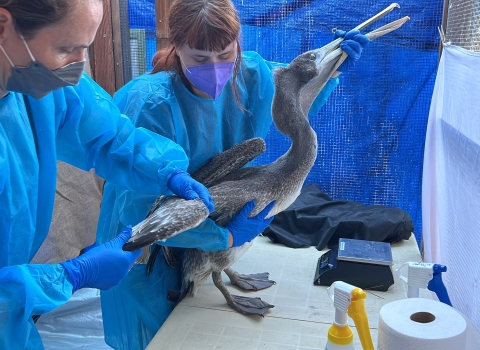DENVER - The endangered Salt Creek tiger beetle is not only one of the worlds rarest insects but also a voracious predator that pounces like a tiger, using part of its mandibles to capture prey that is as big as it is.
This amazing beetle is only found in the salty muddy banks of the Little Salt Creek near Lincoln, NE. To try to save it from extinction and conserve the habitat it calls home, the U.S. Fish and Wildlife Service (Service) is releasing the Salt Creek Tiger Beetle Final Recovery Plan, which includes identification of important recovery areas in Lancaster and Saunders Counties. The plan guides management of the beetle for the next decade, describes actions necessary for the beetle’s recovery, and establishes criteria for both downlisting (to threatened status) and delisting the species. It also includes the time and cost for implementing the needed recovery actions.
Only a total of several hundred adult Salt Creek tiger beetles currently exist, distributed across four populations along a single stream—Little Salt Creek. This saline wetland is at risk from habitat loss due to urbanization, bank stabilization, and agricultural development.
The Service and numerous local organizations have dedicated tremendous resources in support of experimental rearing, reintroduction, and population and habitat monitoring to help recover the Salt Creek tiger beetle and restore its habitat. Local partner organizations include the Saline Wetlands Conservation Partnership, Nebraska Game and Parks Commission, Lower Platte South Natural Resources District, City of Lincoln, Nebraska Environmental Trust, University of Nebraska, Lincoln Children’s Zoo, Henry Doorly Zoo, and the Master Naturalists.
According to the recovery plan, the Salt Creek tiger beetle will be considered for downlisting from endangered to threatened when, along with other habitat-based criteria identified in the plan, three protected wild populations, numbering between 500-1,000 individuals each, are established in three recovery areas; the species will be considered for delisting when three additional protected, wild populations are established in a minimum of four recovery areas and these populations remain stable during 10 consecutive years.
The mission of the U.S. Fish and Wildlife Service is working with others to conserve, protect, and enhance fish, wildlife, plants, and their habitats for the continuing benefit of the American people. We are both a leader and trusted partner in fish and wildlife conservation, known for our scientific excellence, stewardship of lands and natural resources, dedicated professionals, and commitment to public service.
Connect with our Facebook page at http://www.facebook.com/USFWSMountainPrairie, follow our tweets at http://twitter.com/USFWSMtnPrairie, watch our YouTube Channel at http://www.youtube.com/usfws and download photos from our Flickr page at http://www.flickr.com/photos/usfwsmtnprairie/.


